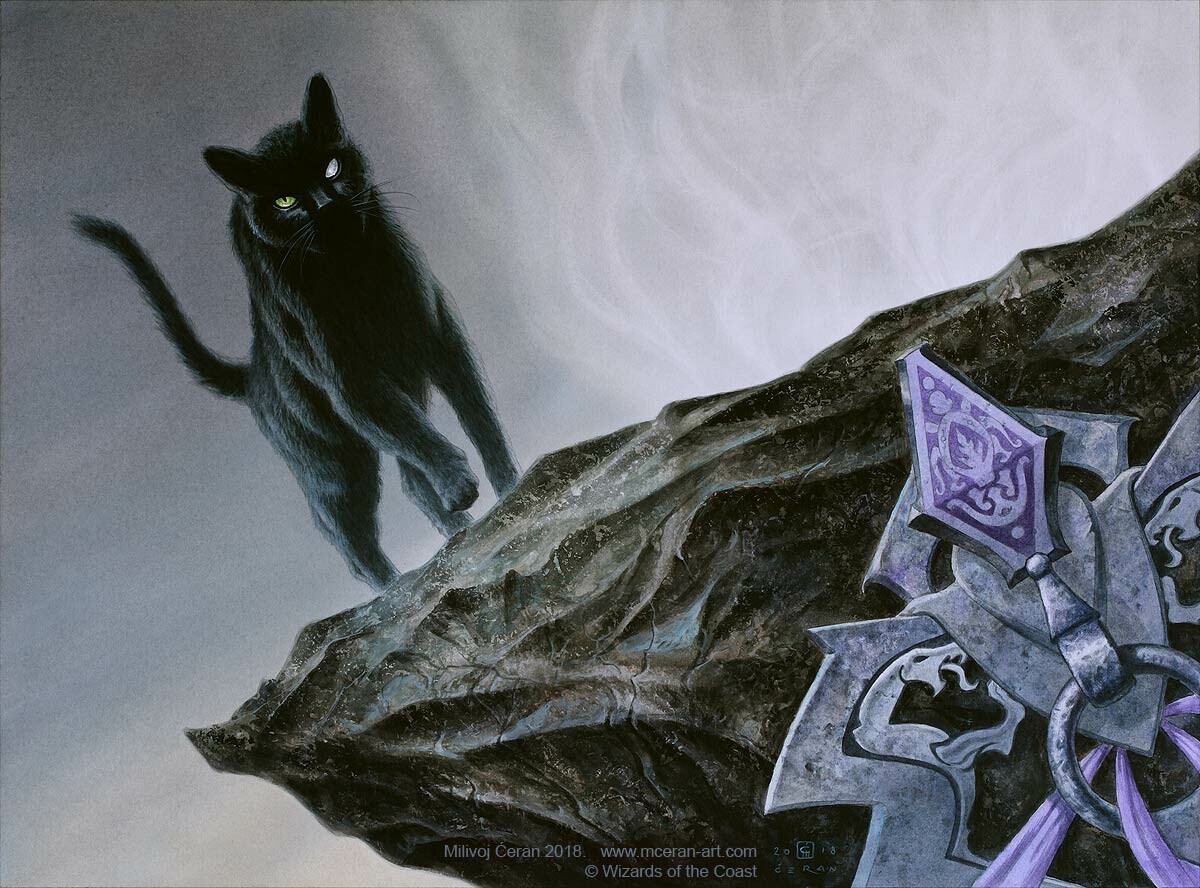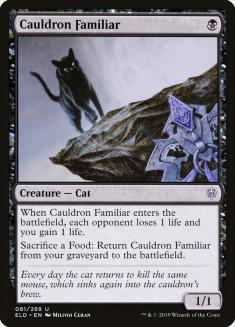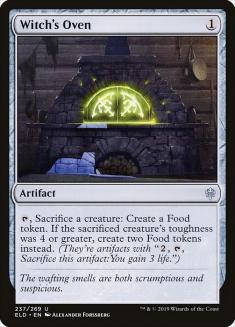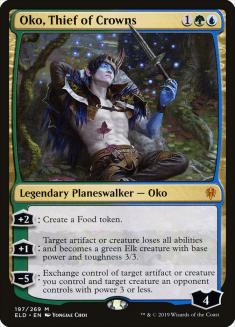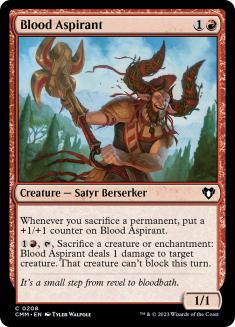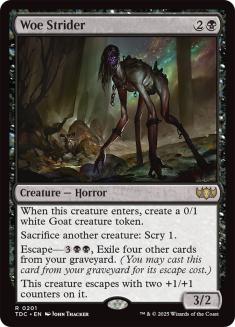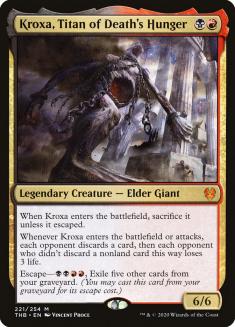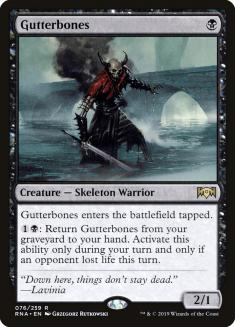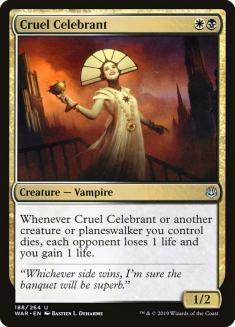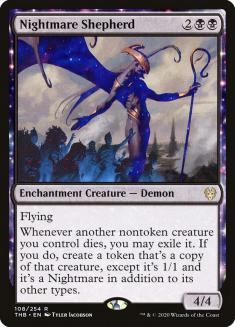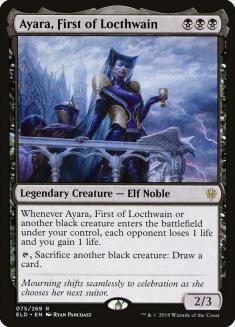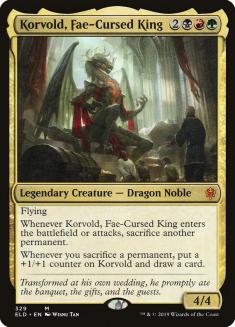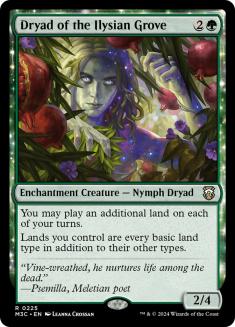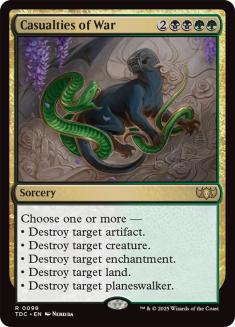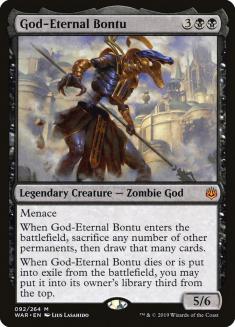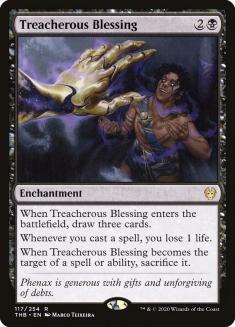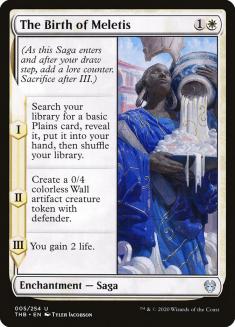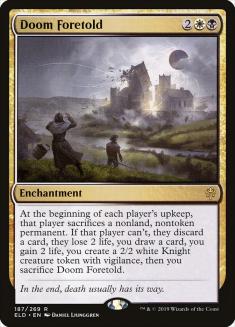So at the risk of beating a dead horse, there’s some incredible stuff in Theros Beyond Death for Standard Sacrifice decks.
Since its initial printing, the Cat-Oven combo has done a ton of work in invalidating the smaller creature aggro decks in the format. What hasn’t always been the same way, however, is the way that people built their Sacrifice decks.
When Throne of Eldraine was first released, the combo appeared fairly innocuous. With Golos, Tireless Pilgrim and Field of the Dead running around, having a Cat to chump block two of the twenty Zombies that were attacking was a bit of a moot point.

This changed completely when people started treating Cauldron Familiar as a sort of Tormented Soul, and attacking with it. When paired with Mayhem Devil and and Priest of the Forgotten Gods, applying pressure was elementary, and the deck had a ton of reach. As the format slowed down and cards like Oko, Thief of Crowns became more prevalent, the deck fell out of favor a bit.
But Oko isn’t here anymore.
Now, it’s easier to reliably close games by attacking without leaning on Embercleave and the squeezes that it puts on deckbuilding.
Creatures (27)
- 4 Gutterbones
- 4 Priest of Forgotten Gods
- 4 Mayhem Devil
- 2 Rankle, Master of Pranks
- 4 Cauldron Familiar
- 3 Woe Strider
- 4 Blood Aspirant
- 2 Kroxa, Titan of Death's Hunger
Lands (23)
Spells (11)

Theros Beyond Death has done a ton of work in fixing problems that plagued Rakdos Sacrifice variants previously.
Blood Aspirant isn’t entirely dissimilar from Tarmogoyf when the entire deck is built to support it. The biggest difference lies in the fact that Tarmogoyf’s ceiling is fairly limited, where Blood Aspirant’s is not. A Cat-Oven combo is going to put a pair of +1/+1 counters on Blood Aspirant every turn. Two or three copies of Oven will make Blood Aspirant dwarf even a Rotting Regisaur.
For the Sacrifice decks that use Priest of Forgotten Gods, there’s generally been a tendency to lean into Lazotep Reaver. The thinking here is that it’s a single card that can immediately produce two bodies the turn after Priest of Forgotten Gods enters the battlefield. With Woe Strider being thrown into the mix, the deck isn’t as priced into playing a glorified Raise the Alarm as it was previously. Now, it has a card that acts as a pseudo-split card, playing the roles of Lazotep Reaver, Viscera Seer, and even Juzam Djinn in longer games.
Having the angle to recur Woe Strider in longer games is particularly nice, as the card selection it provides removes some amount of incentive to play Midnight Reaper in a deck that otherwise wants to commit more resources towards attacking.
Speaking of grindy elements and reach, Kroxa, Titan of Death’s Hunger is an incredibly natural fit for the deck. It isn’t going to be doing much in the early-game most of the time, but the fact that its body can be used for Priest of Forgotten Gods and company with its own sacrifice trigger on the stack gives it that extra bit of value to make it worth having.
At a glance, the deck may appear to struggle enabling Kroxa itself. There aren’t that many spells to fill the graveyard, and five other cards is a pretty steep escape cost. But something to keep in mind with this style of deck is that the way the games play out, the sacrifice elements of the deck will naturally fill the graveyard. Alternatively, the opponent will interact, which happens to have a way of putting cards in the graveyard as well.
The strength of the base-level aggro plan from Rakdos Sacrifice is frequently going to be related to how powerful a fast 2/1 is. Gutterbones is a great Savannah Lion on its front, but if players are playing tons of Arboreal Grazers and Thassa’s Oracle, it’s going to be more embarrassing. This forces the Rakdos Sacrifice deck to lean a little bit more into its synergies, rather than simply punking people out of games in the early turns.
Creatures (27)
- 3 Midnight Reaper
- 4 Priest of Forgotten Gods
- 4 Lazotep Reaver
- 4 Mayhem Devil
- 2 Rankle, Master of Pranks
- 4 Cauldron Familiar
- 3 Woe Strider
- 3 Kroxa, Titan of Death's Hunger
Lands (21)
Spells (12)

Rather than attacking people to death, this version of the deck returns to Lazotep Reaver and Midnight Reaper. The plan? Abuse the free sacrifice outlet in Woe Strider, create turns with as many Mayhem Devil and Midnight Reaper triggers as possible, and put the game out of reach.
Lazotep Reaver and Midnight Reaper both contribute to filling the graveyard a bit more reliably than Gutterbones and Blood Aspirant, so it’s easier to incorporate another copy of Kroxa.
Another approach to synergy prioritization is simply incorporating more cards that are meant to be part of a synergy.
Creatures (29)
- 2 Midnight Reaper
- 1 Tithe Taker
- 2 Gutterbones
- 4 Priest of Forgotten Gods
- 4 Cruel Celebrant
- 4 Mayhem Devil
- 2 Murderous Rider
- 4 Cauldron Familiar
- 3 Woe Strider
- 3 Nightmare Shepherd
Lands (21)
Spells (10)

Popularized by Noah Walker, this deck looks like a lot of moving parts, and that’s because it is a pile of levers and buttons. Cruel Celebrant is a great way to close a game when played in conjunction with a sacrifice outlet, and has the benefit of creating damned-if-you-do/damned-if-you-don’t situations in combat, even without one.
Because the deck has access to both Mayhem Devil and Cruel Celebrant and each pay their controller for sacrificing creatures, Nightmare Shepherd having the ability to virtually “double” the number of creatures to be sacrificed is a plus in favor of the card over Rankle.
Against an opponent that isn’t looking to interact, this is the best deck at simply racing. That’s because so many of its cards are reliant on having synergies, but are absolutely incredible once they’re online. Most of the cards immediately function once they hit the battlefield, or only take a single turn cycle to come online.
While we’re on the topic of busted Nightmare Shepherd payoffs:
Creatures (29)
- 4 Gray Merchant of Asphodel
- 2 Gutterbones
- 4 Priest of Forgotten Gods
- 4 Lazotep Reaver
- 4 Ayara, First of Locthwain
- 4 Cauldron Familiar
- 4 Woe Strider
- 3 Nightmare Shepherd
Lands (24)
Spells (7)

It’s been a long time since we’ve gotten to mention Gray Merchant triggers, but here we are.
This deck is loaded up on ways to immediately sacrifice Gray Merchant of Asphodel the turn it enters the battlefield and abuse Nightmare Shepherd’s synergy with it. Lazotep Reaver and Woe Strider bother have their own enters-the-battlefield abilities to benefit from Nightmare Shepherd loops and everything.
Because this deck is ultimately looking to slam the door shut with a Gray Merchant trigger or two, its curve leans more aggressive. The goal here is to deal a few points of early damage and then use the Merchant to deal the “final” fourteen points or so.
For something a little less reliant on the combat step:
Creatures (29)
- 4 Gray Merchant of Asphodel
- 3 Midnight Reaper
- 2 Priest of Forgotten Gods
- 3 Murderous Rider
- 4 Ayara, First of Locthwain
- 4 Cauldron Familiar
- 4 Woe Strider
- 3 Tymaret, Chosen from Death
- 2 Nightmare Shepherd
Lands (25)
Spells (6)

This is the Mardu to the previous deck’s Rakdos. Rather than having as reasonable a fair gameplan, this deck is looking to filter to a copy of Bolas’s Citadel, cast it, and win within a turn. Gray Merchant of Asphodel gives more life to keep going with Citadel. Ayara and Woe Strider make it so there are fewer bricks in the deck.
The list itself is rough, but something like this is absolutely worth exploring, especially when considering how all of the sacrificing the deck does can interact with Midnight Reaper. Sure, the deck might not win the instant that Bolas’s Citadel hits the battlefield, but it’s difficult to imagine a deck with all of these filtering pieces untapping with a Citadel and not winning.
On the side of long-term planning, Piotr Glogowski’s Mythic Championship VII win in Long Beach has shifted the Sacrifice archetype to include Trail of Crumbs and other Food generators.
Creatures (22)
- 4 Mayhem Devil
- 1 Massacre Girl
- 4 Gilded Goose
- 3 Korvold, Fae-Cursed King
- 3 Murderous Rider
- 4 Cauldron Familiar
- 3 Dryad of the Ilysian Grove
Lands (21)
Spells (17)

What appears to be a tight maindeck at this point can give way to a bit of hotly debated technology in Dryad of the Ilysian Grove.
When the land count is upped a bit for the sake of compensation, Dryad is able to perform the Game 1 roles of both Beanstalk Giant and Thrashing Brontodon. The beauty of the card is that it does the most important halves of both cards on the third turn. Sure, Thrashing Brontodon being a maindeck Naturalize has value, but developing a reasonable body on the third turn was what allowed Jund Sacrifice to maindeck the card. Being able to play literally anything over Beanstalk Giant that isn’t as fragile as a mana creature is a boon to the deck that can’t be understated.
A divisive card in the Jund Sacrifice community as of late, Casualties of War has had fluctuating value over the last few weeks. With its efficacy varying as wildly as it can from matchup to matchup, some players have looked to eschew the card completely:
Creatures (22)
- 4 Mayhem Devil
- 1 God-Eternal Bontu
- 4 Gilded Goose
- 3 Korvold, Fae-Cursed King
- 3 Murderous Rider
- 4 Cauldron Familiar
- 3 Dryad of the Ilysian Grove
Lands (21)
Spells (17)

Inspired by Samuel Graebner, this version of Jund is leaning closer to being a full-on combo deck, rather than a grindy synergy deck.
God-Eternal Bontu is always a signpost for a Sacrifice deck that is interested in cheesing their opponent out of a game on the back of its Mayhem Devil interaction. Rather than trying to even engage with what the opponent is doing, the goal of these takes on the deck are to simply build the biggest bomb that it can, and then detonate it.
Treacherous Blessing is a great tool for a deck that wants to simply create a pile of cards, regardless of what the text of those cards is. Korvold and Bontu are both ways to easily get Blessing off the battlefield once its gotten some use, and generate more value out of the fact that it’s an enchantment, rather than a Painful Truths.
That being said, when looking for ways to generate value out of the near-infinite resources that Trail of Crumbs and Treacherous Blessing can provide, there’s more than one way to skin a cat:
Creatures (9)
Planeswalkers (2)
Lands (18)
Spells (31)

With all of the enchantments in Theros Beyond Death, it’s easy to create a deck that has a ton of permanents to feed Doom Foretold, without resorting to cards as mopey as Guild Globe.
The Birth of Meletis, in particular, subtly provides a couple of different things for the deck. On top of giving the deck a reasonable defensive two-drop, it helps the deck cheat a little bit on its land count. The 0/4 it produces? It has the requisite toughness for Witch’s Oven to pay its owner with an extra Food token (which means an extra Cat or Goose activation).
The Birth of Meletis also creates a bunch of interesting decision tress related to when it’s best to cast it. Generally speaking, getting to sacrifice the Saga to Doom Foretold or Vraska, Golgari Queen is going to be stronger than simply gaining two life. On the other hand, sandbagging the card for too long runs the risk of not getting value out of the card while it’s still relevant to be generating an 0/4, and so on.
As long as this deck can continue finding (nontoken) permanents to sacrifice, Doom Foretold is going to effectively Edict all of the opponent’s relevant spells for as long as they have them. This translates to simply needing to generate Food tokens, and then offering the Food to an incredibly durable kitty.

The biggest question is, with Treacherous Blessing Thrown into the mix, how necessary is Trail of Crumbs?
Creatures (6)
Planeswalkers (4)
Lands (21)
Spells (29)

This is an Esper Control deck that’s masquerading as a combo deck. Rather than using things like counterspells as its control element, it uses its ability to invalidate cards with Doom Foretold in order to buy time before getting to its kill condition.
I’d already touched on it before, but Dance of the Manse getting to shake off the Golden Eggs that it was playing before, without sacrificing velocity, is incredible. Teferi, Time Raveler allows his controller to get rid of Treacherous Blessing if it’s too painful. That doesn’t even get into the power of curving The Birth of Meletis into Teferi, minusing to re-buy The Birth of Meletis.
Cauldron Familiar is simply an advantage engine that buys resources and time in this shell. Rather than being the incentive, it’s just a cog in the machine.

The number of cards that care about permanents being sacrificed, or generated, or creatures dying, is absolutely startling when considering that Cauldron Familiar and Witch’s Oven are both legal. As the format evolves, more and more decks that utilize this nearly free engine are going to pop up. It’s all in knowing how many ways the duo can be used, and how that can be converted to an advantage.

